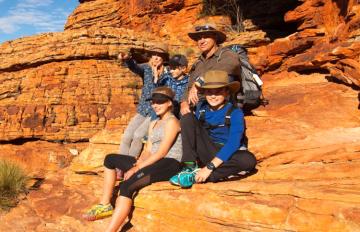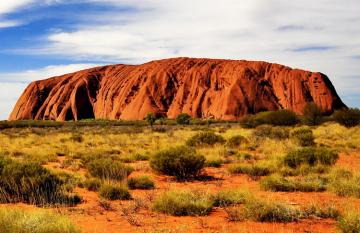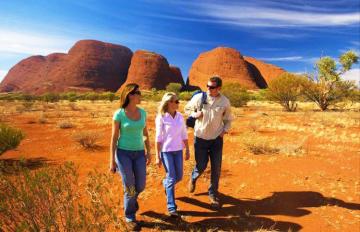
Uluru, an impressive sandstone monolith set in the Uluru-Kata Tjuta National Park in Australia’s Northern Territory, has been an essential part of the Aboriginal culture for tens of thousands of years. Uluru has made headlines around the world after a climbing ban came into effect earlier this year. But what exactly is the significance of Uluru and how will the climbing ban affect your visit to the site? Read on and we’ll tell you all you need to know before your trip.
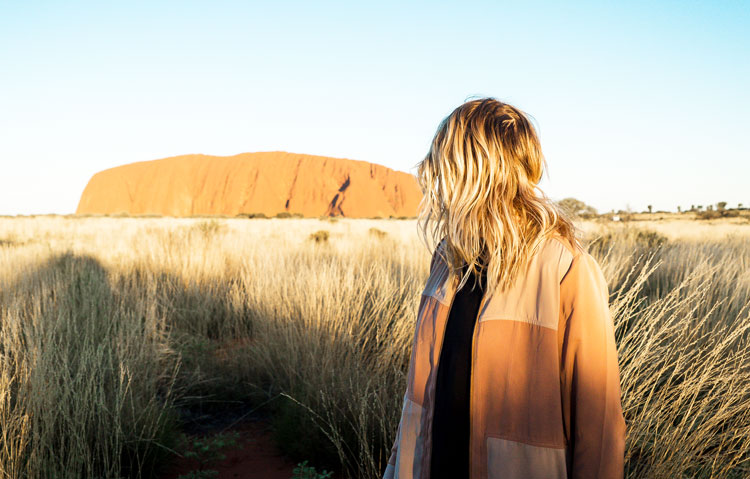
Contents
Why Should I Visit Uluru?
Uluru may be one of Australia’s most recognizable landmarks, but it is not just any item to check off your bucket list. You may be wondering: what is so special about it?
Uluru is the world’s second-largest monolith, after Mount Augustus in the US. But Uluru is much more than a giant rock. When seen in the context of tens of thousands of years of history, this magical place with its ever-changing colours takes on a whole new meaning. Only when you make it to Uluru, will you begin to understand why a quarter million people every year make the trip from across the world just to get a glimpse of the ancient site.
Uluru’s remote location in the Australian outback is inconvenient—it is a six hours drive from the nearest large town, Alice Springs. But this is precisely where its beauty lies. Imagine the almost four hundred meters high auburn monolith standing out from the surrounding landscape in all its solitary greatness. The majesty of this place is guaranteed to leave you in awe.
In 1987, the Uluru-Kata Tjuta National Park was added to the UNESCO World Heritage List for its extraordinary geological origins and wildlife unique to the area. Ten years later, the park made it to the list again, this time for its cultural significance. Uluru is one of the few places in the world that appear on the UNESCO World Heritage List more than once.
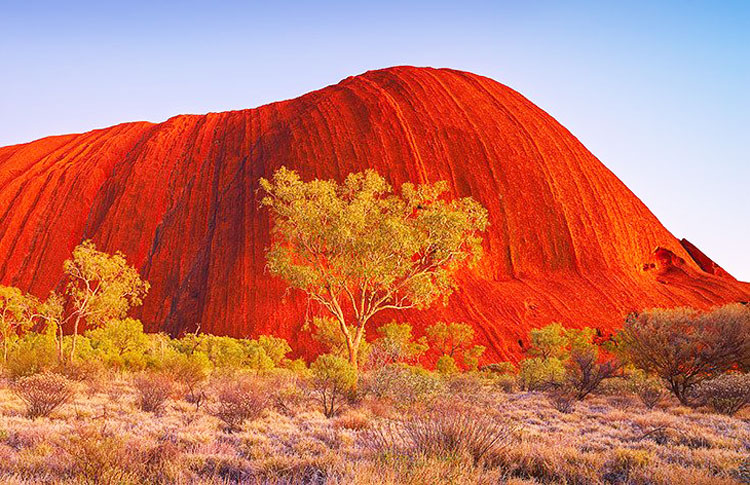
What Exactly Is Uluru?
Uluru was created 600 million years ago, around the same time the Australian continent was formed. In geological terms, it is an inselberg or island mountain, a prominent structure rising from the surrounding plain. And Uluru is only the tip of this unusual land iceberg: the entire formation extends more than 2.5 kilometres underground.
Uluru lies near the edge of the region called the Amadeus Basin, which was once a shallow sea that collected sediments over several hundred million years. After the mountains in the area gradually eroded, huge amounts of sediment washed away and formed deposits of gravel and sand, called alluvial fans. The original sediments that formed Uluru and Kata Tjuta came from that ancient Himalayan-sized mountain range. Uluru consists of layers of coarse red sandstone known as arkose. Its striking red colour is due to the oxidation of the iron-bearing minerals of the rock—without it, Uluru would be grey.
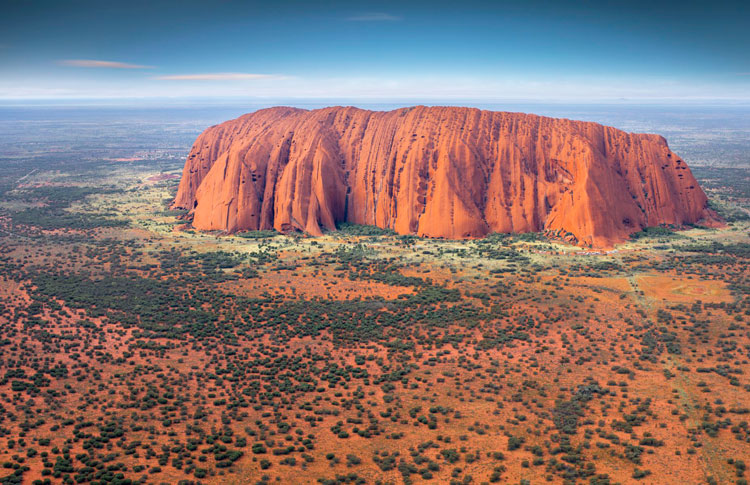
Why Is Uluru Important?
The traditional Aboriginal Australian owners of Uluru-Kata Tjuta are called the Anangu people. Anangu are one of the oldest human societies who have inhabited this area for at least 30,000 years. For Anangu, Uluru is the centre of the universe. They believe that great ancestral beings emerged from the void at the beginning of time. They created the landscape surrounding Uluru and all living species. Being the direct descendants from the traditional creator spirits, Anangu were designated to protect the ancestral lands.
The foundation of Anangu culture is the Tjukurpa law, that embodies the principles of religious belief and behaviour. Anangu see it as their main responsibility to maintain Tjukurpa, a tradition that connects them with each other and with their land.
Anangu ancient laws and traditions are passed down from generation to generation through Dreamtime stories that explain how each section of the earth was formed. For Anangu, Uluru marks the place where Dreamtime began, when the land and the people were created by the ancestral spirits.
Anangu are extremely knowledgeable about the flora, fauna, landscape, and history of the Uluru-Kata Tjuta National Park. They still hunt in remote areas of the park just like they have done in the past.
The Anangu people have always considered themselves to be the traditional owners and guardians of the Uluru-Kata Tjuta National Park. In 1985, they handed over the park to the Australian government on a 99-year lease. Today, Uluru is jointly managed by the Anangu and the National Parks and Wildlife Service of Australia.
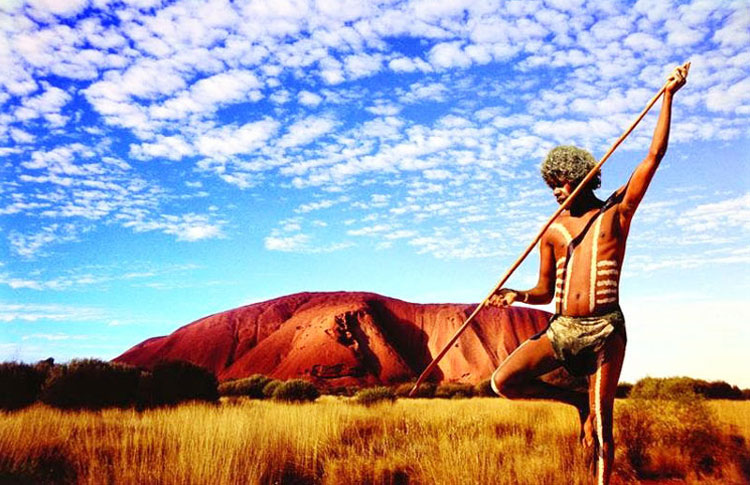
How to Get to Uluru
Uluru is located 450 km from Alice Springs and 25 km from the town of Yulara which houses a small airport. There are several ways to reach Uluru:
By car
It is too far to drive from Sydney and other major Australian cities to Uluru, unless you have time for a very long trip (at least 30 hours non-stop). However, you can rent a car in Alice Springs and visit Uluru as part of a road trip through the Australian outback. Many people who travel to Uluru choose this option.
Sample itinerary: 6 Day Red Centre Self Drive from Alice Springs
By coach
Several luxury coach tours, including comprehensive commentaries of the outback scenery, depart from Alice Springs. The trip to Uluru takes approximately 6 hours.
View our Northern Territory Luxury Coach Tour selections
By plane
Ayers Rock (Uluru) Airport, also known as Connellan Airport, is located 30 km from Uluru.
There are direct flights to Yulara from a number of Australian cities, including Sydney, Melbourne, Brisbane, Darwin, Adelaide, and Alice Springs.
Jetstar and Virgin Australia have direct daily flights from Sydney. Jetstar also operates regular direct flights from Melbourne and Brisbane. Qantas offers daily flights from Sydney and Melbourne via Alice Springs, a daily direct flight from Cairns, as well as twice-weekly direct flights from Darwin and Adelaide.
If you are visiting from abroad, purchasing Qantas Aussie AirPass is one of the most economical ways to include Uluru into your Australian itinerary.
Connellan Airport has no taxi services, however, most hotels in Yulara provide shuttle buses for their guests.
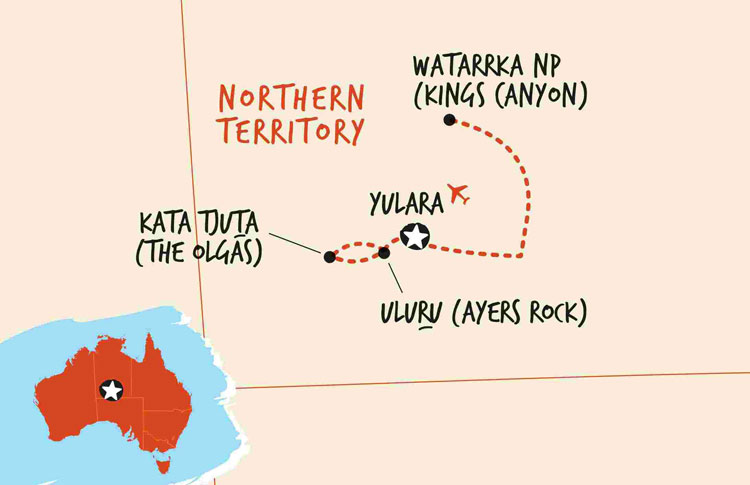
When Is the Best Time to Visit Uluru?
Uluru weather is extreme—summer temperatures soar to 47°C while in winter, night temperatures can drop to -10°C. So what is the best time to visit?
May to September
The ideal time to travel to Uluru is between May and September when day temperatures cool down to around 28°C, the rock colours are more vibrant, and the sky is perfect for stargazing. August and September are the best months to travel if you wish to see the park’s wildflowers in bloom.
Not surprisingly, this period is by far the busiest time for tourists, particularly for US and European visitors. Be prepared for crowds and peak prices in flights, accommodation, and tours.
September to November
Australian spring months still have pleasant temperatures with highs around 30°C. Crowds have dissipated and you’ll find better deals for your stay. This time of the year is also ideal for taking photos of Uluru.
December to February
You should definitely avoid Australia’s summer when considering a trip to Uluru. Temperatures often exceed 35°C and exploring the park can easily turn into an uncomfortable experience.
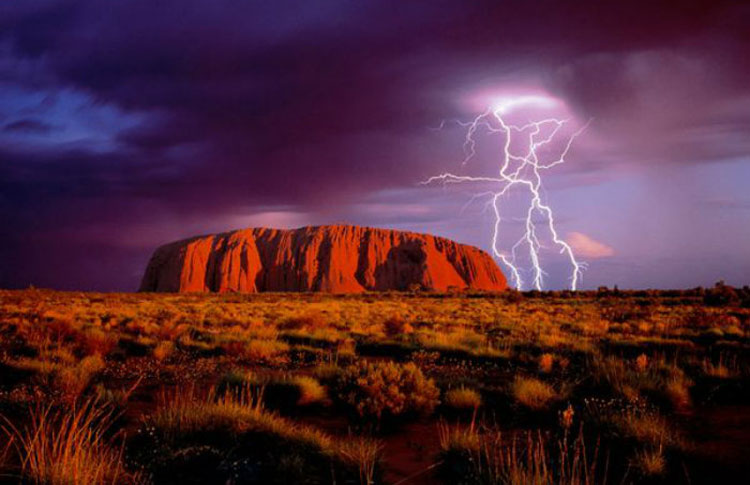
The Climbing Ban
Anangu don’t climb Uluru. They believe that the only track was used by ancestral Mala shamans to access its summit on ceremonial occasions. Anangu have long advocated a climbing ban on the rock that has been a popular climbing site since the 1930s.
In November 2017, Australia’s National Park Board voted unanimously to close Uluru to climbers. The climbing ban came into effect on 26 October this year, 34 years since the site was handed by the Australian government to the Anangu.
In the years preceding the ban announcement, many visitors had already become more sensitive to the beliefs and traditions of the indigenous people. In 2015, only 16% of tourists climbed the rock. Some past climbers have even sent back memorabilia they collected on Uluru, which are referred to as “sorry rocks”.
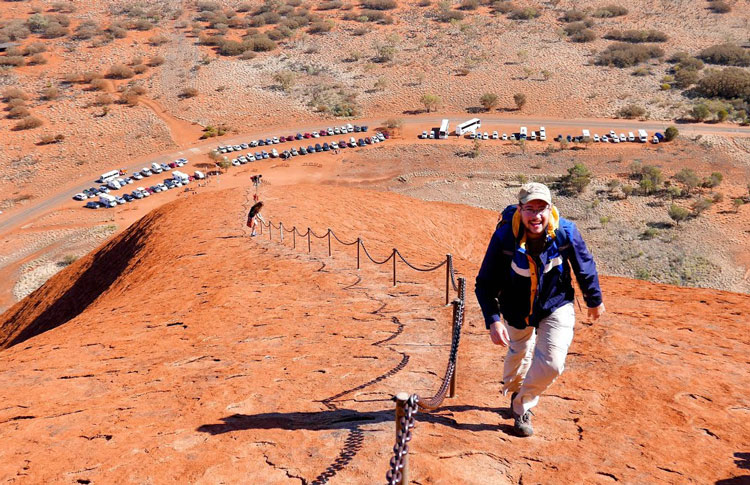
What Is There to Do in Uluru After the Ban?
Uluru-Kata Tjuta national park offers no shortage of fascinating sights and activities and you’ll need several days in order to make the most of your experience.
Cultural Centre
Make the Cultural Centre your first stop when visiting Uluru. Learn more about its origins, the indigenous people who live there, and about the significance of the Uluru walks.
Rock art sites
Explore the rock art sites around Uluru to get a better understanding of the Anangu culture. Petroglyphs made from natural minerals and white ash that depict Anangu creation stories are considered national cultural treasures. Anangu rarely create new rock art today, but they still use the ancient drawings to tell Dreamtime creation stories and pass on their traditions and beliefs.
Hiking
The most popular hikes in the park include the 10-kilometre Uluru base walk, the Mala walk where you can learn more about the Anangu’s ancestors, and Walpa Gorge walk ideal for observing Uluru’s rich wildlife and even spotting a few wallabies.
Birdwatching
With 178 types of birds, including some rare species, Uluru-Kata Tjuta is a bird-lover’s paradise. The best spot for birdwatching is the idyllic Lungkata walk.
Stargazing
Uluru has one of the most impressive skies in the world for stargazing. Low humidity, lack of light pollution and clear night skies mean there is nothing to interfere with a perfect view. Due to Uluru’s location in the Southern Hemisphere, you can catch a glimpse of Magellanic clouds—a dwarf satellite galaxy of the Milky Way—and the Southern Cross constellation that can be seen only in this part of the world.
Sunrise and sunset watching
Uluru is famous for its breathtaking sunrise and sunset views with the rock changing colours before your very eyes. Two designated viewing areas provide the best viewpoints for sunrise and sunset watching.
Exploring Kata Tjuta
Kata Tjuta or Mount Olga, an impressive group of 36 large dome-shaped rocks 25 kilometres west of Uluru, is another major landmark within the park.
Visiting Kings Canyon
Kings Canyon is known for its scenic Rim Walk, stunning rock formations, and lush gorges. Located 320 km from Uluru, it is a perfect day-trip destination.
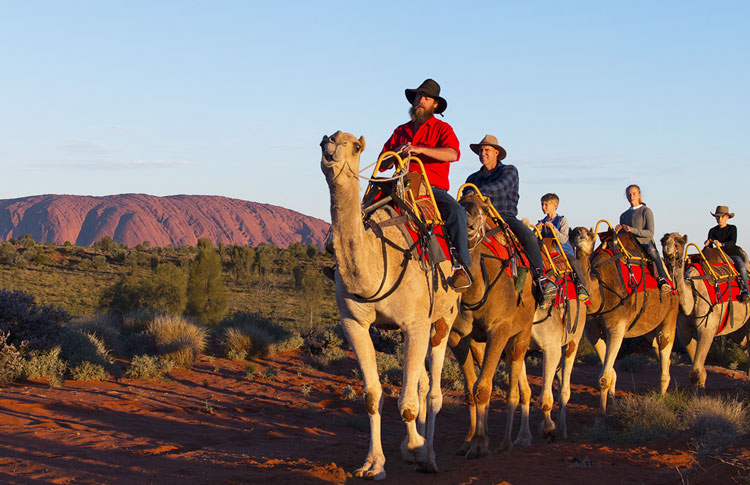
Things to Know Before Visiting Uluru
Uluru-Kata Tjuta National Park is open every day, all year round. The park opens between 5 am and 6.30 am and closes between 7.30 pm and 9 pm, depending on the season.
Avoid queues and purchase the park pass online. The admission fee is $25 per adult for a three-day pass, which can be extended to five days at no extra cost.
There is no accommodation within the park itself and visitors are not allowed to spend the night in the park. The tiny town of Yulara houses the Aboriginal-owned Ayers Rock Resort where you can find everything from accommodations (including a campground) to restaurants, shops, and galleries.
Make sure to charge your phone and download any guides and apps before visiting. The Cultural Centre has free Wi-Fi.
Bring your best camera. This is a once-in-a-lifetime opportunity for taking some phenomenal photos.
Check the weather before you travel and pack accordingly. Keep in mind that Australian seasons are opposite from the Northern Hemisphere.
Wear a hat, sunscreen, and sunglasses to protect yourself from the heat and scorchingly hot desert sun.
Keep in mind that the terrain around Uluru is very rough. A pair of sturdy comfortable hiking shoes is a must.
It takes around 3.5 hours to walk around the base of Uluru.
The air in the park is often thick with flies. Don’t forget to bring insect repellent and a face net. You can also purchase them on site.
Drink lots of water to avoid dehydration.
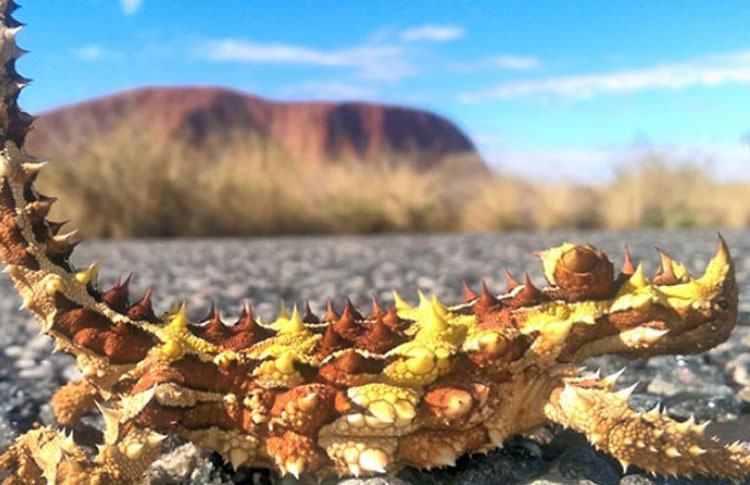
Dos and Don’ts When Visiting Uluru
Dos
Remember that for Anangu Uluru is a sacred site. Be respectful of local traditions and beliefs.
Try activities like skydiving, take a helicopter tour or go for a camelback ride through the park.
Join an Anangu guided tour and listen to the Uluru Dreamtime stories told by the Aboriginal people themselves.
Don’ts
Don’t climb Uluru. Anyone caught breaking the ban and climbing the rock risks a heavy fine.
Don’t take photographs in places where it is forbidden to do so. Anangu believe that the spirits of the ancestral beings dwell in Uluru, and they still hold rituals in the caves around the base of the rock. Visitors are asked to refrain from taking photos or videos of those sacred ceremonies.
Don’t feed dingoes—they may be cute, but feeding them only encourages the wild animals to gather in tourist areas.
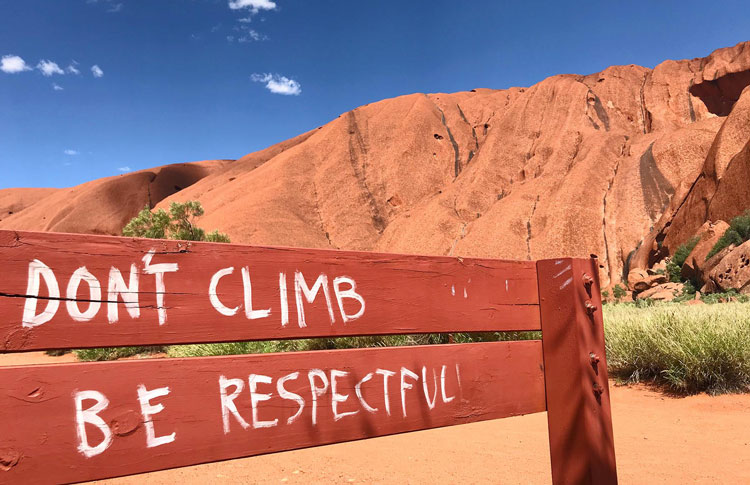
Lets Recap: Is Uluru Worth Visiting?
Definitely. Let’s recap what are some of the many outstanding experiences Uluru has to offer:
See one of the oldest geological formations in Australia
Witness the incredible natural beauty
Watch some of the most spectacular sunsets and sunrises anywhere in the world
Observe a canopy of stars and constellations that will leave you breathless
Experience a unique landscape and an abundance of wildlife
Make most of the wonderful photography opportunities
Learn firsthand about the spiritual significance that Uluru holds for Anangu
Make most of the fantastic hiking opportunities
Participate in a variety of fun activities in the park
Join educational tours and learn more about the Aboriginal culture
Start Planning Your Trip to Uluru
Ready to visit Uluru? Let our experts help you plan your trip. The service is completely free, so why not give it a try today?
Ready to Start Planning your travels to the Red Centre?
Here are some self-drive trips to get you started.
Recent Posts
Blog Categories
Blog archives
- April 2024 (1)
- March 2024 (13)
- February 2024 (3)
- January 2024 (5)
- December 2023 (6)
- November 2023 (4)
- October 2023 (11)
- September 2023 (2)
- August 2023 (6)
- July 2023 (2)
- June 2023 (17)
- May 2023 (3)
- April 2023 (5)
- March 2023 (8)
- February 2023 (9)
- January 2023 (12)
- December 2022 (9)
- November 2022 (12)
- October 2022 (12)
- September 2022 (12)
- August 2022 (6)
- July 2022 (9)
- June 2022 (7)
- May 2022 (3)
- April 2022 (4)
- March 2022 (6)
- February 2022 (1)
- January 2022 (4)
- December 2021 (2)
- November 2021 (3)
- October 2021 (1)
- September 2021 (4)
- August 2021 (10)
- July 2021 (13)
- June 2021 (6)
- April 2021 (2)
- March 2021 (2)
- February 2021 (1)
- January 2021 (1)
- December 2020 (2)
- November 2020 (3)
- October 2020 (2)
- September 2020 (1)
- August 2020 (1)
- July 2020 (1)
- June 2020 (1)
- May 2020 (1)
- April 2020 (1)
- March 2020 (1)
- February 2020 (2)
- January 2020 (4)
- December 2019 (2)
- November 2019 (1)
- October 2019 (1)
- September 2019 (5)
- August 2019 (1)
- July 2019 (5)
- June 2019 (1)
- May 2019 (1)
- April 2019 (1)
- March 2019 (1)
- February 2019 (1)
- January 2019 (1)
- December 2018 (1)
- October 2018 (1)
- May 2018 (1)
- February 2018 (1)
- December 2017 (1)
- October 2017 (1)
- June 2017 (1)
- May 2017 (1)
- February 2017 (1)
- January 2017 (1)
- September 2016 (1)
- August 2016 (2)
- July 2016 (1)
- June 2016 (1)
- May 2016 (1)
- April 2016 (1)
- December 2015 (1)





